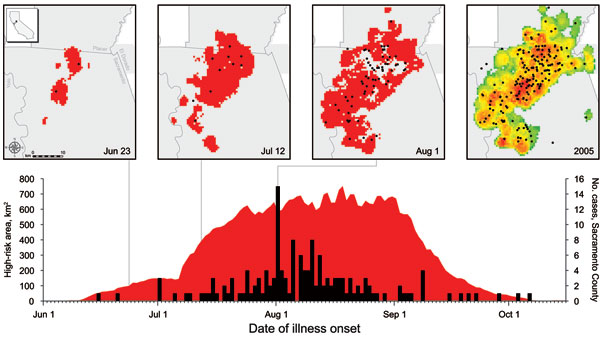Volume 17, Number 8—August 2011
Research
Early Warning System for West Nile Virus Risk Areas, California, USA
Figure 3

Figure 3. Dynamic Continuous-Area Space-Time (DYCAST) risk maps (top) and timeline (bottom) of West Nile virus epidemic in Sacramento County, California, 2005. Within timeline, black bars represent reported human cases within Sacramento County by date of onset of illness (n = 152; 11/163 cases were missing spatial and/or temporal data), and red region represents total area in Sacramento County designated by DYCAST as high risk by date of analysis. Maps illustrate areas of high-risk (red) cells during the last day of pilot-phase analysis (Jun 23), which detected the 2 emerging clusters seen above in the Arden-Arcade and Citrus Heights regions, as well as during rapid expansion of high-risk areas (Jul 12) and the peak of the epidemic (Aug 1). Map at far right displays cells color coded by number of days designated by DYCAST as high risk during 2005, from green (low) to red (high) (range 1–94 days, mean 47.7 days, median 51 days, SD 19.9 days). Human cases with onset of illness before or including respective date of analysis are shown as black circles; gray area represents DYCAST analysis regions. Inset at top left illustrates location (black square) in California corresponding to the risk maps. Data were mapped by using ArcMap version 9.3.1 (Environmental Systems Research Institute, Inc., Redlands, CA, USA) and North American Datum of 1983, High Accuracy Reference Network (NAD83 HARN) California II State Plane coordinate system (Lambert Conformal Conic Projection).
1Current affiliation: Brown University, Providence, Rhode Island, USA.
2Current affiliation: University of British Columbia, Vancouver, British Columbia, Canada.